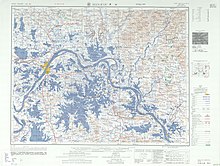Talk:蘄

The following information has failed Wiktionary's verification process (permalink).
Failure to be verified means that insufficient eligible citations of this usage have been found, and the entry therefore does not meet Wiktionary inclusion criteria at the present time. We have archived here the disputed information, the verification discussion, and any documentation gathered so far, pending further evidence.
Do not re-add this information to the article without also submitting proof that it meets Wiktionary's criteria for inclusion.
Rfv-sense: "variety of artemisia seek". It comes from the Unihan database, but what does it even mean? — justin(r)leung { (t...) | c=› } 23:02, 7 January 2018 (UTC)
- The "variety of artemisia" part is easy: the genus Artemisia includes a number of medicinal/aromatic herbs such as wormwood, mugwort, sagebrush, sweet Annie etc., as well as tarragon. Judging by some of the Google hits (none of which I can read), there may be another species involved, Crossostephium chinense, which was originally classified as Artemisia chinensis. The "seek" part looks like stray text- perhaps a note to look for more information. Chuck Entz (talk) 02:19, 8 January 2018 (UTC)
- I think it's likely that the definition is referring to 蘄艾/蕲艾 then, which is Crossostephium chinense, as you have suggested. — justin(r)leung { (t...) | c=› } 00:55, 11 January 2018 (UTC)
- Rfv failed. Dokurrat (talk) 17:35, 20 February 2018 (UTC)
The character 蘄 (qí) on this map appears to me to have the configuration ⿱艹單⿰斤 instead of the expected ⿱艹⿰單斤. I don't know whether this is a variant form or a mistake of some kind.

--Geographyinitiative (talk) 05:28, 3 June 2020 (UTC)
- @Geographyinitiative: Looks like a calligraphic variant that's common for other characters of similar structure. The IDS should be ⿰⿱艹單斤 rather than what you have, which isn't computable. It may be "unifiable" with this Unicode character, but I'm not sure. — justin(r)leung { (t...) | c=› } 06:17, 3 June 2020 (UTC)